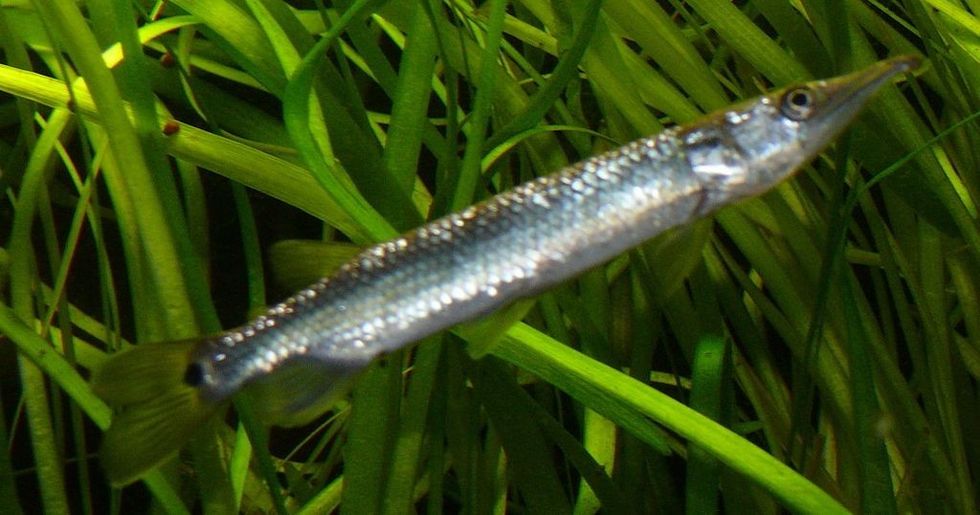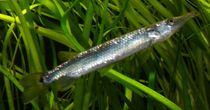The bicuda (Boulengerella cuvieri) is a type of fish that belongs to the freshwater rivers. This fish is native to the Amazon basin.
The bicuda fish inhabits freshwater, pelagic, and tropical waters. These fish are endemic to the Amazon basin and are popularly found in regions of Peru, Brazil, and South America. Bicuda (Boulengerella cuvieri) fishes are pelagic, meaning they are found in the open seas.
The adult bicuda (Boulengerella cuvieri) tends to be in the region of flowing stretches of main river channels and larger tributaries of both white and black water rivers as well as floodplain lakes. The bicuda fish have a long and slender body with long thin tails.
This giant fish has a barracuda-like body. This fish is greenish-gray in color which dorsally fades to yellowish-white vertically.
This giant fish has a line of small darker scales along the lateral line. The tails of these fish are dirty yellow with small black spots on the tail wrist.
The mouth is small and long with sharp small teeth that protrude outside its small mouth. These fish are not very territorial and so they should not be put together with aggressive or competitive species. The best choice is to put them with similar-sized fishes.
Other surface-dwelling fish are best avoided although some hobbyists report success keeping it alongside related fish. This is why it is safe to say, this species, particularly the juveniles, is rarely aggressive.
Keep on reading to learn more interesting facts about the bicuda fish. For more relatable content, check out these warmouth facts and tilefish facts for kids.
Bicuda Fish Interesting Facts
What type of animal is a bicuda fish?
The bicuda (Boulengerella cuvieri) is a type of fish that belongs to freshwater rivers. This fish is native to the Amazon basin.
What class of animal does a bicuda fish belong to?
The bicuda (Boulengerella cuvieri) belongs to the class of Actinopterygii.
How many bicuda fish are there in the world?
The exact number of bicuda (Boulengerella cuvieri) fish that are present in the world is unknown. However, this species belongs to the existing fish species of the Amazon basin.
Where does a bicuda fish live?
Bicuda fish inhabit freshwater, pelagic, and tropical waters. These fish are endemic to the Amazon basin and are popularly found in regions of Peru, Brazil, and South America. This species is largely unsuitable for a home aquarium given the size and natural behavior. Their most suitable environment is the wild river and the open sea.
What is a bicuda fish's habitat?
Bicuda (Boulengerella cuvieri) fishes are pelagic which means they are found in the open seas. The adult bicuda (Boulengerella cuvieri) tends to be in the region of flowing stretches of main river channels and larger tributaries of both white and black water rivers as well as floodplain lakes.
The bicuda fish inhabit freshwater, pelagic, and tropical waters. This species is largely unsuitable for the home aquarium given its size and natural behavior. Their most suitable environment is the wild river and the open sea.
Who do bicuda fish live with?
Bicuda (Boulengerella cuvieri) fishes are schooling fishes. These fishes live and travel in large groups like most fish that belong to the family of Ctenoluciidae.
Many surface-dwelling fish are best avoided although some hobbyists report success keeping bicuda fish alongside related fish. This is why it is safe to say that the juveniles specifically are not aggressive and rather exhibit a marked schooling instinct whilst older and larger individuals tend to be more solitary.
They still group together from time-to-time and they are best kept in numbers of four.
How long does a bicuda fish live?
The average lifespan of a bicuda (Boulengerella cuvieri) is not known yet. However, these fish are quite large in size.
How do they reproduce?
Sexual maturity of the bicuda (Boulengerella cuvieri) is achieved when the fish are about 9.8 in (250 mm) in size. The spawning season of this fish typically lasts between November and March, when water levels are highest in the river.
Reproductive activity, including courtship and spawning, is the reason for a majority of sounds known to be produced by fishes. Among many such sound-producing animals, it is the male that produces sound to try to spawn with a receptive female.
This fish species is solitary in nature for a part of the year and later turns to a group. These fish reproduce through gynogenesis.
This means that the genetic material of the male species is not incorporated into the offspring of the female. The daughter cells that are produced are copies of the mother cells.
What is their conservation status?
The conservation status of this fish is Not Evaluated by the IUCN. This species is found in large numbers in their habitual river and throughout their natural habitat. IT might be assumed that they are far away from the threshold of being Vulnerable.
Bicuda Fish Fun Facts
What do bicuda fish look like?
Bicuda fish have a long and slender body with long thin tails. This giant fish has a barracuda-like body. This fish is greenish-gray in color that dorsally fades to yellowish-white vertically.
This giant fish has a line of small darker scales along the lateral line. The tails of these fish are dirty yellow with small black spots on the tail wrist. The mouth is small and long with sharp small teeth that protrude outside its small mouth.
These sharp teeth are filled with numerous small sandpaper-like teeth. These fish are 34.6 in (88 cm) in length. This fish is considered to be a giant fish considering its huge size and length.
* We've been unable to source an image of bicuda fish and have used an image of spotted pike-characin instead. If you are able to provide us with a royalty-free image of bicuda fish, we would be happy to credit you. Please contact us at hello@kidadl.com.

How cute are they?
These fishes are not very cute to look at. This fish is rather large with sharp teeth and a slender body that closely resembles a giant fish. The description of this fish on its own sounds pretty unappealing.
How do they communicate?
For communication to happen between these fishes, an intentional signal or sign has to be generated by one fish or more fish. This form of communication has to be reviewed by other fish.
Among the many ways of communicating in aquatic environments, the fish of this genus communicate by creating a sound which is the most effective form of communication compared to the other forms that exist in these regions of the wild water, especially over long and large distances.
Sounds produced by fishes for communication are commonly associated with either reproduction, stressful situations, or territorial fights.
Reproductive activity, including courtship and spawning, is the reason for a majority of sounds known to be produced by fishes. Among many such sound-producing animals, it is usually the male that produces sound to try to spawn with a receptive female.
How big is a bicuda fish?
The adult bicuda fish is 34.6 in (88 cm) in length. It is considered to be a large fish and it is one of the giant fish of the family. The baby bicuda size is half of the adult fish.
How fast can a bicuda fish swim?
This giant fish is known for its swift swimming. The slender and slim body with long fins enables this fish to swiftly swim through temperate waters. The exact speed of the fish is not known but it can swim pretty fast in the wild.
How much does a bicuda fish weigh?
This giant fish weighs 13.2 lb (6 kg). This weight is quite heavy for fish, especially of this genus.
What are the male and female names of the species?
There are no sex-specific names given to the male and female species of this fish.
What would you call a baby bicuda fish?
Similar to all other baby fish, the baby bicuda too is called a fry
What do they eat?
These fish primarily feed on smaller fishes and insects in nature but also adapt well to dead alternatives in captivity.
The younger fish of this species can be offered bloodworm, chopped prawns, and small earthworms, while adults can be fed strips of fish flesh, whole prawns, shrimps, mussels, river shrimp, and larger earthworms. Like most giant fish in the wild, these fishes should not be fed mammalian or avian meat such as beef or chicken.
Similarly, there is no benefit in using feeders such as livebearers or small goldfish as food for this fish species as they might carry with them the risk of parasites or diseases.
Are they poisonous?
No, these fish are not poisonous in any way. They do not harm humans in any way. This fish is safe to consume and is free from toxins.
As these fishes not territorial, they should not be housed with fish species that are aggressive, territorial, or competitive. The best choices for them are similar-sized fish. Other surface-dwelling fish are best avoided although some hobbyists report success keeping this bicuda alongside other related fish.
Would they make a good pet?
No, these giant fish do not make good pets only because these fishes grow to be quite large. These fish require the correct temperature and atmosphere in order to survive.
Did you know...
This species forms 30% of the fish species in the Amazon basin.
How many eggs do bicuda fish lay?
The bicuda fish lay an average of 5,000 eggs typically at the end of November.
Is the bicuda fish aggressive?
No, these fish are not very territorial. As these fish are not territorial, they should not be housed with fish species that are aggressive, territorial, or competitive.
The best choices for them are similar-sized fish. Other surface-dwelling fish are best avoided although some hobbyists report success keeping it alongside the related fish.
This species is not aggressive towards conspecifics with juveniles, in particular, and exhibits a marked schooling instinct. Older and larger individuals tend to be more solitary but still group together from time-to-time and they are best maintained in numbers of four.
Here at Kidadl, we have carefully created lots of interesting family-friendly animal facts for everyone to discover! Learn more about some other fish from our moonfish fun facts and jellyfish fun facts for kids pages.
You can even occupy yourself at home by coloring in one of our free printable fish mosaic coloring pages.
Main image by User: haplochromis
Second image by H. Zell









